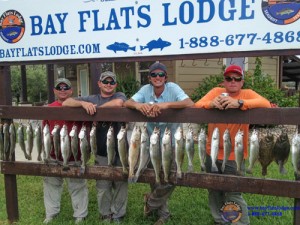
Scooter Wells with CCA Victoria, Texas with Captain Harold in San Antonio Bay with live bait. -Bay Flats Lodge
Since the last edition of Guide Lines, we have had a couple frontal passages hit us that have had a northerly influence associated with them. Summertime northerly wind generally means flat water and cooler temperatures for a short period of time, so it’s great to be able to take advantage of such situations as they occur. The drop in air temperature that we’re talking about here may not be more than five or ten degrees, but we’ll take whatever break we can get in the oppressive heat of July and August. And the period of time in which the bay chop becomes settled may only be overnight or for only a concise portion of a day, but when it happens it can always be a very nice time to try your luck in some of those places you normally might not be able to fish in during the summer due to otherwise strong southerly winds.
The surf is always a good place to venture during periods of north wind in the summertime, and we have talked at length in the past about all the things the surf has to offer coastal anglers during the warmer months of the year. However, when these areas of low pressure crossed our region this past month, we decided we were going to attempt to locate a trout bite in the bays along some of the shorelines that normally get pounded on a daily basis by the strong winds that tend to blow out of the south most of the time. This particular morning happened to be the day following the latest front which completed its passage through our area late in the afternoon on the previous day. It was 5:00am, and The Weather Channel was stating that the winds were currently blowing NNE at 7mph, and that today’s winds would be shifting easterly at 9mph throughout the day, and they would then become SSE by the end of the day.
We set course for a northern section of West Matagorda Bay shoreline that we normally would never consider during the summer months. We arrived there right at sunrise only to find that the overnight wind had emptied a lot of the shoreline of its normal water level. The remaining water was clean and green, however, and we sighted an occasional jumping mullet along the water’s surface in some of the rather shallow water that was between us and the bank.
We set anchor as the morning sky was beginning to brighten, and we exited the boat in thigh-deep water that was quite a distance from the grass-lined shore. This stretch of shoreline closely resembled any imaginable portion of the Gulf surf, as the contour here was made up of a number of troughs and sandbars positioned parallel to the shore, with the bay floor consisting of hard sand. The one added feature we had here which commonly isn’t found in the surf was the presence of scattered beds of oyster shell.
It was still early morning and we were presenting top water baits to potential targets in some of the more shallow water. It wasn’t long before I got my first blow-up, but the initial strike had fallen short, and my bait sat motionless atop the calm water. I simply twitched the bait a couple times and let it sit again. A few seconds later the fish hit the lure again, but still didn’t inhale it. I repeated the process twice and received the same result both times. I retrieved the bait and retraced that same route several times, but the fish were no longer interested.
As the sun rose the wind became all but calm, and the air and the water began warming rapidly. We replaced our surface walkers with plastic tails and started heading for the coolness of deeper water. We situated our wade so as to be able to cast our lures parallel to a long, skinny oyster reef that protruded a great distance out into deeper water. As we headed away from the shoreline, we discovered a strike zone right against the edge of the submerged reef. The bite wasn’t coming from directly above the shell, but rather from the edge of the reef where the shell transitioned to sand. Hits became constant, so I set my feet in the sand and didn’t move a bit for quite a while as almost every cast was met with some sort of reward – either trout, red fish, black drum, or even an occasional flounder, in sizes ranging anywhere from ten to twenty-four inches. The bite remained somewhat consistent until around noon when the wind began blowing out of the south at about 12mph. As a result, we all voted to end our day short. However, we all experienced a good time because we had been willing to try locating fish in a place where we normally would not consider doing so during this time of the year.
Until next time, remember to practice CPR, “Catch, Photo, and Release”, whenever possible on trophy Trout and Reds…Guide Chris Martin, Port O’Connor/Seadrift region…www.BayFlatsLodge.com…1-888-677-4868
